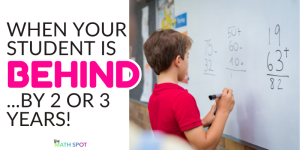This post contains affiliate links. This means that when you make a purchase, at no additional cost to you, I will earn a small commission.
If you have a student who might be considered behind in math it can be hard to know where to start so that they can catch up. Sometimes it seems like your student needs “everything”. A few simple principles can help you to determine priorities and set you and your student up for success..

When a Student is “Behind In Math” Start With What They Know
It can feel overhwelming when it seems like a student needs “everything” in math. We can simplify the list of what a student needs by starting with what a student does know! Rather than starting each of your interventions by considering tier 1 instruction and working to backmap to previous standards start with what your student knows and can do and work up from there!
Bounce back and forth thinking about numbers and operations. You are looking to see which numbers your student “knows about” from a number sense and place value understanding lens and then notice which operations your student is able to carry out using those numbers.
Questions to Ask Yourself About Numbers
Start by thinking about numbers to 10– or even numbers to 5 if you are working with kindergartners who have had little exposure to numbers ahead of your instruction!
- Can your student count to 10?
- Does your student recognize the numbers 1-10?
- Does your student have number sense around numbers to 10? (For example, knows one more/one less than a given number, can decompose numbers to 10, can subitize numbers to 10 using regular dot patterns or dots on a ten frame)
- Can your student demonstrate an understanding of addition and subtracting for numbers within 10?
- Does your student have strategies for solving addition problems within 10?
- Does your student have strategies for solving subtraction problems within 10?
- Can your student solve simple word problems within 10?
If your student is confident in each of these skills, move ahead to larger numbers! Consider:
- Numbers to 5 or 10
- Numbers to 20 (teen numbers lay a foundation for place value understanding!)
- Numbers to 50
- Numbers to 100
- Numbers to 1,000
- Numbers to 1,000,000
- Fractions & Decimal Numbers
When you find the range of numbers your student is working in you can help them to develop understandings more easily because they are not overwhelmed by numbers that they can’t conceptualize!
Questions to Ask Yourself About Operations
In the list above we considered whether or not students had an understanding of addition and subtraction and if they had strategies for solving addition or subtraction numbers. As numbers expand, these strategies will develop and the operations of multiplication and division will be added in as well.
Strategies for solving addition, subtraction, multiplication and division follow a general sequence so the strategies you are looking for in your students will develop sequentially as well.
Level 1 Strategies: Counting All
- Can your student solve addition problems by counting both parts and then counting the total?
- Can your student solve an addition problem by counting all and taking away?
- Can your student solve multiplication problems by arranging objects into equal groups or arrays and counting to find the product?
- Can your student partition into equal groups, “dole out” one at a time or arrange into rows and columns counting all to divide?
Level 2 Strategies: Counting Strategies
- Can your student “count on” to add? (ex: 5 + 3 is counted as *5* 6,7,8)
- Can your student count up to find the difference?
- Can your student skip count to find a product or quotient?
Level 3 Strategies: Related Fact Strategies
- Can your student decompose and work flexibly with numbers in order to add, subtract, multiply or divide more easily?
- The “Make a Ten” addition strategy is an example of a related fact strategy because students could solve 7 + 4 by thinking of the related fact 7 + 3 and then adding one more.
- A related fact strategy for multiplication might look like a student who solves 6 x 5 by thinking of it as 5 x 5 (a known fact that they feel comfortable with) and then one more group of 5.
Resources for Teaching Math Intervention Lessons
If you are looking for “done for you” math intervention units that include the assessment, lessons and independent practice that you and your students need, look no further! The units bounce back and forth between numbers and operations to help you and your students work from where they are to where they need to be.
1st Grade Math Intervention | 2nd Grade Math Intervention | 3rd Grade Math Intervention








